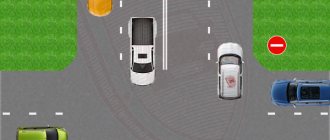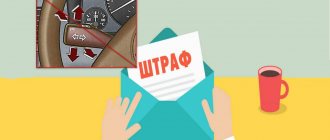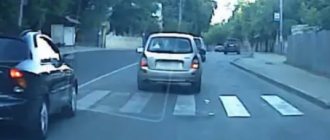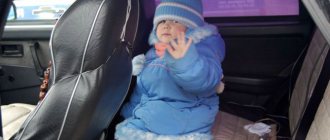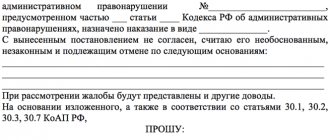Characteristics of the sign
“Entry prohibited” is a symbol that indicates that further movement of the vehicle is unacceptable. A brick marks a section of the road where the movement of a car is partially or completely prevented in a particular direction. However, this requirement does not apply to all types of vehicles. Some cars are allowed into the restricted area, and drivers are not punished with fines or other measures.
In what cases is it installed
A sign identifies a section of the road on which traffic should be limited. The law does not clearly describe in what situations a prohibitory symbol must be present.
Among the most common cases are the following:
- Reverse direction on one-way roads;
- Entry into areas where only route vehicles are allowed to travel;
- Driving through areas that cannot be reached from the direction where the sign is installed.
“No Entry” is often used in businesses to prevent unauthorized movement within the area. In such cases, the installation of the symbol must be carried out with simultaneous approval from the traffic police. Otherwise, it may be considered invalid and no one will receive a punishment for driving under a brick.
Responsibility for driving under a “No Entry” sign
Article 12.16 of the Code of Administrative Offenses of the Russian Federation is devoted to the issues of imposing fines and other sanctions for driving under the sign “Entry prohibited”. The size of the fines depends on the specific situation in which the driver ignored the sign’s coverage area, and on whether this violation was committed once or repeatedly. The penalty also depends on the circumstances under which the violation was recorded - with the participation of a traffic police inspector or with the help of traffic cameras .
Ignoring the sign
The mildest punishment for driving through a “No Entry” sign in 2018 is a verbal warning or a fine of 500 rubles. This measure of liability is applicable in the case of driving into a courtyard area in front of which a “brick” is installed (Part 1 of Article 12.16 of the Code of Administrative Offenses of the Russian Federation).
Other cases when a minimum fine is issued are ignoring a sign when going around repair work on the road, driving under the arch of a multi-story building on which a “brick” is hanging, or ignoring a sign when entering or exiting an adjacent area (for example, from a gas station).
U-turn or left turn
For a left turn or a U-turn associated with a violation of the requirements of the “No Entry” sign, if these maneuvers are made for the first time, an administrative fine is imposed in the amount of 1,000 to 1,500 rubles (Part 2 of Article 12.16 of the Code of Administrative Offenses of the Russian Federation).
Entering the public transport lane
If the driver ignored the effect of the “brick” installed on the public transport lane and allowed movement or parking in the specified lane, then he will have to pay 1,500 rubles to the state budget (Part 1.1 of Article 12.17 of the Code of Administrative Offenses of the Russian Federation).
If the entry into a public traffic lane was made in a city of federal significance (Moscow or St. Petersburg), then the fine will double and amount to 3,000 rubles (Part 1.2 of Article 12.17 of the Code of Administrative Offenses of the Russian Federation).
Driving in the oncoming lane
For ignoring the “brick” installed on one-way roads, that is, for driving into the oncoming lane, the driver will have to pay a fine of 5,000 rubles or lose his license for a period of 4 to 6 months (Part 3 of Article 12.16 of the Code of Administrative Offenses of the Russian Federation ).
If the specified violation was committed repeatedly (twice within one year, which is calculated from the date of payment of the previous fine for a similar violation), and it was noticed by a traffic police inspector, then the driver will be deprived of his license for a period of 1 year (Part 3.1 of Article 12.16 of the Code of Administrative Offenses of the Russian Federation ).
If movement in the oncoming lane is recorded by traffic cameras, then deprivation of rights will not be applied. The case will be limited to a fixed administrative fine of 5,000 rubles.
Grounds for fine
There are different ways to violate traffic rules regarding driving under a brick. Further punishment for the illegal action depends on this. Sometimes the driver is only warned. It is recommended to consider several cases in which the owner of a vehicle will face a fine for a brick in 2021.
These include:
- Driving through the surrounding area. Drivers often ignore the symbol that prohibits driving to a parking lot or gas station. Despite the fact that these areas are not the main road, they are also marked and regulated by signs. In this case, the amount of the fine for violation reaches 500 rubles.
- Driving in the oncoming lane. On roads where traffic is one-way, a brick is installed as a warning signal. If the driver neglects the ban, the fine can reach 5 thousand rubles.
How to challenge sanctions
The imposition of a fine for “brick” is one of the most appealed violations. Inaccurate wording in laws, incorrect installation of signs and disagreement with the extent of responsibility lead many drivers to court to challenge the decision of inspectors. Those who were not driving the car at the time it drove under a brick, which was recorded on camera, have a greater chance of having their fine receipt invalidated. There are often positive decisions in favor of drivers when the installation of a sign is controversial or there is no direct evidence of the movement of the car.
Expert opinion
Artemyev Dmitry
Experience as a forensic expert in the field of automotive technical examination for more than 2 years, more than 3 years of work in the field of insurance disputes, appealing guilt in road accidents.
Ask a Question
You can file a complaint about disagreement with the issued fine to the management of the traffic police department, to which the inspector who issued the receipt for the traffic violation belongs. It is also possible to go to court. In both cases, it is necessary to write a statement indicating that the inspector was wrong and that there were no violations. If possible, evidence of your innocence should be attached to the papers. This must be done within 10 days after receiving the fine receipt.
If the driver was stopped by an inspector and accused of driving under a “brick”, which is not visible when entering the corresponding section of the road, this must be indicated in the protocol. The traffic police officer is obliged to reflect in it all the comments of the car owner. In this case, it is advisable to take photographs proving the insufficient visibility of the sign. Correct actions will help you avoid liability for driving under a “brick.”
Amounts of fines
The size of the sanction varies depending on the specifics of the violation. Obviously, the penalty is greater in cases where failure to comply with traffic rules creates dangerous conditions for other road users. The average fines for driving under a brick are discussed below.
| Nature of the violation | Recovery amount (RUB) |
| Driving on single-lane roads against the direction of general traffic | 5 thousand |
| Entering a yard or parking lot under a prohibitory sign | 500 |
| Driving in a bus lane | 1500 |
| Driving under a prohibiting sign to a place of work | 500 |
The fine for driving under a “No Through” sign varies based on numerous factors. It can be extremely difficult for drivers to understand the nature of the violation, especially if traffic police officers do not support this with the relevant articles from the Code of Administrative Offenses. Therefore, in case of illegal actions, the inspector issuing a fine is obliged to notify the exact reason, indicating the nature of the violation.
Procedure for imposing a fine
A traffic police inspector can impose a fine for driving in violation of a “no entry” sign in 2021. An alternative is to bring the person to justice after the camera records non-compliance with traffic rules. The method of detecting a violation directly affects the design features.
If the procedure is performed by a traffic police officer, he is obliged to comply with the norms of Federal Law No. 3 of February 7, 2011 “On the Police,” and also take into account the provisions of Order of the Ministry of Internal Affairs of the Russian Federation No. 664 of August 23, 2021. In 2021, the inspector must act according to the following scheme:
- If you notice a violation, stop the car.
- Say hello, introduce yourself and ask the citizen to show documentation. Its list is recorded in paragraph 2.1.1 of the Russian Traffic Regulations.
- Report that a violation has been committed.
- Draw up a report on the administrative offense and provide documents for review to the driver. He can sign the paper or refuse to perform the action. In the latter case, the corresponding mark is affixed.
- Release the driver.
- A resolution on an administrative offense is being prepared. The document is sent to the driver. The procedure is carried out by mail or through the State Services portal. In the latter case, the citizen must have an account. If an account has not been created in the system, the resolution is sent only by mail (Article 28.6 of the Code of Administrative Offenses of the Russian Federation).
When it comes to depriving a driver’s license for driving under a “brick,” a representative of the traffic police goes to court, initiating the start of proceedings. A statement of claim is being drawn up. It is supplemented by a resolution and evidence base. The citizen will be sent a summons, which will reflect the time and place of the hearing.
Passage under the “brick” can be detected automatically. In this case, in 2021 the scheme for bringing to responsibility changes:
- The camera records people allowed to pass under the “no entry” sign.
- The received information is processed.
- A resolution is being prepared.
- The document is sent to the driver. Shipping takes place by mail.
The decision must be made within 15 days (Article 29.6 of the Code of Administrative Offenses of the Russian Federation).
Additional penalties
In case of gross violations of traffic rules, especially when driving on a single-lane road against the direction of travel, in addition to a fine, the driver may be subject to other types of liability. We are talking about deprivation of rights for a period of 4-6 months.
Attention! If the violation was recorded repeatedly using surveillance cameras or other means of video recording, the ID may be confiscated for up to 1 year. At the same time, the owner of the car is obliged to pay a fine of 5 thousand rubles. Similar penalties are used in a situation where an unlawful action was recorded by a traffic police inspector.
In what cases can rights be revoked?
If a driver drives into the oncoming lane while passing a prohibitory sign, he may be deprived of his license for 6 months. This is due to the fact that a gross violation of the rules is being committed, which creates a dangerous situation on the road. There are frequent cases of head-on collisions between cars when one of them drove under a brick.
If the violation is committed again, the driver will be deprived of his license for a year. However, such a measure is imposed if the violation is recorded by a traffic police inspector, and not by a video camera.
Is it possible to challenge
There are ways to prevent a fine or deprivation of your license for driving under a brick in 2021. This method works in cases where the sign was installed incorrectly. In this situation, the driver can appeal the decision, citing the fact that he did not notice the prohibiting symbol.
In accordance with GOST, the “brick” must be located in a visibility zone of at least 100 m. The distance from the road is no more than 2 m, and the height is no higher than 3 m. If these requirements are not met, the offender has the opportunity to challenge the fine. This can be done immediately upon registration. Another way is to file a complaint with the traffic police at your place of residence.
Appealing a fine
The opportunity to appeal the decision is enshrined in Article 30.1 of the Code of Administrative Offenses of the Russian Federation. Features of the procedure are recorded here. If an inspector has made a decision, or a demand has been received to pay a fine for driving under a brick from a camera, in 2021 you need to contact the head of the traffic police department who imposed the monetary penalty, provide documentation to a higher authority or the district court at the place of consideration of the case.
To appeal the decision imposing a fine for driving under a brick in 2021, 10 days are given from the date of receipt of a copy of the document (Article 30.3 of the Code of Administrative Offenses of the Russian Federation). If a period is missed, its restoration is acceptable. The procedure requires the submission of a petition to the person who will consider the complaint. It is important to have good reasons. The exact list is not reflected in the legislation. The decision will be made by the person reviewing the application. If the request to restore the deadline is granted, the complaint will be accepted. In a different situation, a determination is made.
If a person wants to appeal a fine for driving under a “no entry” sign in 2021, they need to proceed according to the following scheme:
- Familiarize yourself in detail with the peculiarities of the current situation, study the decision and determine the reason for the appeal. The reason may be false data, imputation of a violation that the citizen did not commit, or the presence of other circumstances.
- Prepare an evidence base. Without it, defending your position is problematic.
- Prepare a complaint. The legislation does not contain the exact form of the document. A citizen can draw up a paper arbitrarily. It is better to use a ready-made sample. This will reduce the risk of errors as mandatory information must be included in the document. Business standards must be followed.
- Submit a complaint. Submission of papers is possible during a personal visit. An alternative is to send documentation by mail or through the official website of the traffic police.
- Wait until the review process is completed. If the appeal is made to the traffic police, the answer will be provided within 10 days from the date of transfer of documents to the authorized body. If there is a trial, the period is extended to 2 months.
As a result of considering a complaint about a fine for driving under a brick, the decision made may be cancelled, adjusted or left unchanged. The verdict can also be appealed by contacting a higher authority or court.
Complaints about driving under a “no entry” sign can be found here.
What categories of vehicles can drive under a brick?
There are a number of exceptions in which cars can drive despite a prohibitory sign. This requirement does not apply to certain categories of vehicles. These include:
- Route and passenger vehicles;
- Cars that are used to transport disabled people;
- Vehicles used in private enterprises;
- Car owners who are residents of the area under the prohibited sign;
- Special equipment and trucks that unload materials during construction, repair or installation work;
- Emergency vehicles and mail.
Driving on a section of road that is marked with a prohibitory sign is considered an offence. This is subject to administrative liability, a fine, and in some situations, deprivation of rights. To prevent punishment, drivers should know when driving under a brick is not prohibited.
Nuances
Sometimes entry restrictions may be temporary. In this case, the “entry prohibited” sign is accompanied by a sign. Most traffic opens after 8:00 pm until early morning. In this situation, driving under the sign will not be considered a violation.
Sometimes, when cameras record a passage under a brick, the evidence comes back with poor quality evidence. Neither the sign nor the markings may be visible in the photo. In this situation, it is recommended to initiate an appeal procedure. The likelihood of defending your rights increases.
Eligibility of the “Brick” installation: legal justification
The main location method for 3.1 is a pillar on the right edge of the roadway. Another option is to go above the restricted lane. Brick, like other road signs, is installed in accordance with GOST R 52289–2004.
In the directives of section 5.4. “Prohibition signs” (clause 5.4.2) contains information about:
- In what cases is “Entry prohibited” established?
- Additional signs attached to the main one.
- Prohibited combinations with other symbols.
- The distance at which the sign is visible should be 100 m. This is achieved due to the reflective coating and the absence of any obstacles, in particular tree branches, advertising, etc.
- The minimum possible gap between the brick and the edge of the road is 50 cm.
- Height – 2-4 m (for the city) and 1.5-3 m (for the countryside).
- When secured to safety islands or portable supports, the height of the location is 0.6-1.5 m.
- If traffic on exits with a single lane is one-way, then the sign may be placed on the left if the flows are separated at different levels.
- If necessary, re-installation is required, since the action lasts until the first intersection. In the absence of the latter, the rule remains in force until the end of the settlement.
Exceptions to the rules
There are categories of drivers to whom this sign does not apply.
In particular:
- drivers of fixed-route transport, subject to entering the traffic lane that was intended for such transport;
- car owners who reversed onto a one-way road.
The possibility of carrying out this maneuver is dictated by the resolution of the Plenum of the Supreme Court of October 24, 2006 No. 18, which deals with the safety of the action and the objective necessity of its implementation. In practice, this is a rather controversial point, which usually does not exclude the imposition of a fine by an employee of the State Traffic Inspectorate. Drivers often use this maneuver when parking in a parking lot or driving around obstacles that arise along the vehicle’s path.
Meaning of a road sign
The road sign number 3.1 is prohibitive. If the driver sees a “brick” in front of him, this means that further driving of the vehicle in the zone starting immediately behind the sign will be a violation of the Traffic Rules. In this case, the motorist will need to look for other detour routes. Thus, the road sign “Brick” means that travel is prohibited.
The rules for placing a sign prohibiting entry are regulated by the state standard GOST_R_52289–2004. A “brick” can be installed in the following cases:
On sections of the road with one-way traffic, prohibiting passage towards the traffic flow;
on lanes intended for public transport (the ban does not apply to trolleybuses, buses, minibuses);
parking zones and gas stations to separate entry and exit zones;
to prohibit travel on a certain lane (in this case, the sign is supplemented with plate 8.14).
Driving under a “brick”: what does this mean for a motorist?
Every driver knows which road sign prohibits entry, because many who, through negligence or simply did not notice, violated them and were punished for it.
What is the price for this today? In 2016, fines depend on what exactly you violated. If you did not see the “brick” and drove through the wrong road to some area, then this will result in a fine of 300 rubles. But if the offense was classified as “driving in the oncoming lane,” then they may even deprive the driver’s license for six months. Or the penalties will increase to 5 thousand rubles.
The amount of the fine can be from 300 to 5000 rubles
How to reduce the fine? It's difficult to change anything here. If the sign was installed correctly and the inspector noticed you, then punishment cannot be avoided. Many drivers manage to reverse when leaving a gas station when the exit is blocked. This is also punishable, only the wording is different and the fine is smaller. Sometimes some motorists even try to drive on a one-way road this way if they are in a hurry or don’t want to make a huge detour. For such driving they will only be charged with “violation of a sign” with a fine of the same 300 rubles.
Criteria for assessing the offense
According to Part 3 of Art. 12.16 of the Administrative Code, the determination of the type of punishment directly depends on the degree of danger that the commission of an offense created for society. If we are talking about a threat to the health and life of citizens, confiscation of a driver’s license for a certain period is used as a punishment. Less significant acts of offenders, as a rule, entail the imposition of penalties.
The basis for bringing the driver to administrative responsibility is the report of the State Traffic Inspectorate employee and the protocol of the inspection of the scene of the incident.
The content of these legal documents, which describe in detail the circumstances of the incident, will determine the degree of danger created by the car owner.
Eyewitness testimony will play a significant role in this case. Confirmation in the form of photographs or videos must also be included in the case materials.
Typically, only a fine is assigned to persons who have a “clean history” - those who have not violated traffic rules.
A separate line is the topic of passing a prohibitory sign in parking areas. The installation of the “Brick” sign in this case serves as a regulator for the uninterrupted movement of transport, its entry and exit. Accordingly, ignoring this sign does not pose a greater danger to the public than other types of driving under a prohibitory sign.


